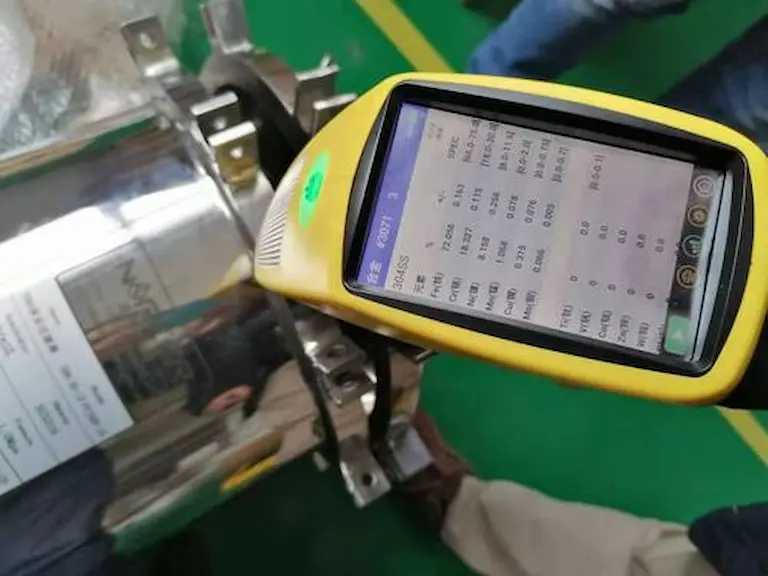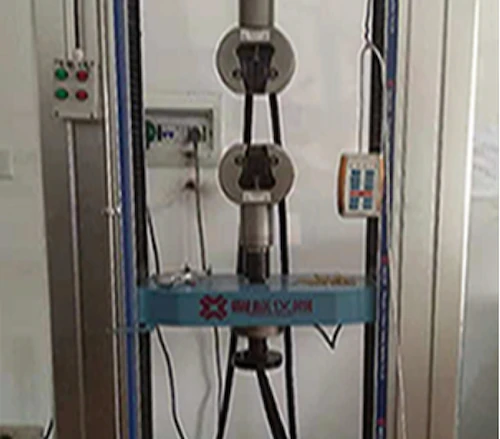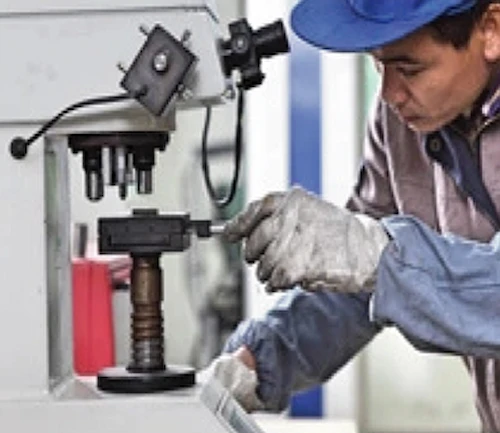Stainless Steel Material Specification: A Comprehensive Guide to Austenitic Grades
Stainless steel material specification is crucial for ensuring optimal performance in industrial applications. Austenitic stainless steels, particularly grades like ss 304 material specification and ss316l material specification, represent approximately 70% of total stainless steel production worldwide. These non-magnetic stainless steels offer exceptional corrosion resistance, formability, and mechanical properties at both cryogenic and elevated temperatures.

Do you know what should know when purchasing stainless steel materials? stainless steel material specification?
Global Stainless Steel Grade Standards: International Equivalents and Specifications
Stainless Steel Grade Standard
| China | USA | Germany | Germany | UK | Japan |
| 12Cr17Ni7 | AISI/SAE | W.-nr. | DIN | BS | JIS |
| 06Cr18Ni9 | 301 | 1.431 | 12CrNi177 | - | SUS 301 |
| 022Cr19Ni10 | 304 | 1.435 | X5CrNi189 | 304S11 | SUS 304 |
| 022Cr19Ni10 | 304L | 1.4306 | x2CrNi1911 | 304S11 | SUS 304L |
| 1Cr18Ni9MoZr | 303 | 1.4305 | X2CrNi188 | 304S21 | SUS 303 |
| 06Cr17Ni11M02 | 304L | 1.4306 | x2CrNi189 | 304S12 | SCS19 |
| 06Cr27Ni12M03 | 316 | 1.4401 | X5CrNiMo1810 | 316S16 | SUS 316 |
| - | 316L | 1.4435 | X2CrNiMo1812 | 316S13 | SUS 316L |
| 06Cr18Ni11Ti | 321 | 1.4541 | X10CrNiTi189 | 321S12 | SUS 321 |
| 06Cr18Ni11Nb | 347 | 1.455 | X10CrNiMo189 | 347S17 | SUS 347 |
| Cr18Ni12M02T | 316Ti | 1.4571 | X10CrNiMoTi18 | 320S17 | - |
| Cr17Ni12M03Mb | 318 | 1.4583 | X10CrNiMoNb18 | - | - |
| 1Cr23Ni13 | 309 | 1.4828 | X15CrNis12012 | 309S24 | SUH 309 |
| 12Cr17Mn6Ni5N | 201 | 1.4372 | - | - | SUS 201 |
| 12Cr18Mn9Ni5N | 202 | 1.4373 | - | - | SUS 202 |
These five regions represent approximately 80% of global stainless steel production and consumption, making their standards crucial for international commerce.
– They form the basis for international material certification
– Major global projects reference these standards
– They influence emerging market specifications
– They guide quality control procedures worldwide
Why do buyers need to confirm the Stainless Steel Grade Standard?
Specifying the exact type of stainless steel material specification is crucial when purchasing because different grades serve distinct purposes and regional standards vary. For example, while a Chinese manufacturer might list a grade as 06Cr17Ni12Mo2, this is equivalent to 316 in the US system or 1.4401 in German standards. Without clear specification, you might receive material that doesn’t meet your requirements for:
1. Chemical resistance (e.g., SS316 vs SS304)
2. Temperature performance
3. Mechanical properties
4. Compliance with local building codes
5. Industry-specific certifications
As the International Stainless Steel Forum (ISSF) states: “Precise grade specification ensures the material meets both performance requirements and regional compliance standards.” This clarity prevents costly mistakes and project delays while ensuring you receive the correct material for your specific application.

stainless steel material specification: Chemical Composition
Stainless steel Chemical Composition
| Type | C | Si | Mn | p | S | Ni | Cr | Mo |
| AISI 201 | ≤ 0.15 | ≤ 1.0 | 5.5~7.5 | ≤ 0.06 | ≤ 0.03 | 3.5~5.5 | 16.0~18.0 | - |
| AISI 301 | ≤ 0.15 | ≤ 1.0 | ≤ 2.0 | ≤ 0.045 | ≤ 0.03 | 6.0~8.0 | 16.0~18.0 | - |
| AISI 304 | ≤ 0.08 | ≤ 1.0 | ≤ 2.0 | ≤ 0.045 | ≤ 0.03 | 8.0~10.5 | 18.0~20.0 | - |
| AISI 304L | ≤ 0.03 | ≤ 1.0 | ≤ 2.0 | ≤ 0.045 | ≤ 0.03 | 9.0~13.0 | 18.0~20.0 | |
| AISI 305 | ≤ 0.12 | ≤ 1.0 | ≤ 2.0 | ≤ 0.045 | ≤ 0.03 | 10.5~13.0 | 17.0~19.0 | |
| AISI 309S | ≤ 0.08 | ≤ 1.0 | ≤ 2.0 | ≤ 0.045 | ≤ 0.03 | 12.0~15.0 | 22.0~24.0 | |
| AISI 310S | ≤ 0.08 | ≤ 1.0 | ≤ 2.0 | ≤ 0.045 | ≤ 0.03 | 19.0~22.0 | 24.0~26.0 | |
| AISI 316 | ≤ 0.08 | ≤ 1.0 | ≤ 2.0 | ≤ 0.045 | ≤ 0.03 | 10.1~14.0 | 16.0~18.0 | 2.0~3.0 |
| AISI 316L | ≤ 0.03 | ≤ 1.0 | ≤ 2.0 | ≤ 0.045 | ≤ 0.03 | 12.0~15.0 | 16.0~18.0 | 2.0~3.0 |
| AISI 317 | ≤ 0.08 | ≤ 1.0 | ≤ 2.0 | ≤ 0.045 | ≤ 0.03 | 11.0~15.0 | 18.0~20.0 | 3.0~4.0 |
| AISI 321 | ≤ 0.08 | ≤ 1.0 | ≤ 2.0 | ≤ 0.045 | ≤ 0.03 | 9.0~13.0 | 17.0~19.0 | |
| J1 | ≤ 0.08 | ≤ 0.75 | 6.0~8.0 | ≤ 0.07 | ≤ 0.015 | 4.0~4.5 | 15.0~17.0 | - |
| J3 | ≤ 0.15 | ≤ 1.0 | 7.5~13.0 | ≤ 0.045 | ≤ 0.03 | 0.8~1.5 | 13.0~15.0 | - |
| J4 | ≤ 0.12 | ≤ 0.75 | 8.5~13.0 | ≤ 0.045 | ≤ 0.015 | 1.0~2.0 | 14.0~16.0 | - |
| Y1 | ≤ 0.14 | ≤ 1.0 | 15.0~19.0 | ≤ 0.035 | ≤ 0.03 | ≤ 1.5 | 12.0~14.5 | - |
| Y6 | 0.1~0.3 | ≤ 1.0 | ≤ 2.0 | ≤ 0.035 | ≤ 0.03 | 0.3~2.0 | 10.7~15.0 | - |
This chemical composition table is crucial for stainless steel material specification because it provides the exact “recipe” that determines a grade’s performance characteristics. According to the International Stainless Steel Forum (ISSF), “Chemical composition is the fundamental basis for stainless steel classification and performance.”
The table is significant for three key reasons:
1. Quality Control: Manufacturers use these precise compositional ranges to ensure material consistency and compliance during production.
2. Performance Prediction: The composition directly determines critical properties:
– Corrosion resistance (Cr, Mo content)
– Mechanical strength (C, Mn levels)
– Weldability (C content)
– Cost (Ni content)
3. Global Trade: It serves as a universal “language” for material verification, allowing buyers and sellers worldwide to confirm they’re dealing with equivalent grades, regardless of regional standards.
The primary differences in the 300 series reflect specific performance requirements:
- AISI 304 vs 304L
- Main difference is carbon content (0.08% vs 0.03%)
- Lower carbon in 304L improves weldability and prevents carbide precipitation
- Same Cr-Ni ratios (18-20% Cr, 8-10.5% Ni)
- AISI 316 vs 316L
- Addition of Molybdenum (2.0-3.0%) for enhanced corrosion resistance
- Lower carbon content in 316L (≤0.03%) for better welding properties
- Higher nickel content for improved formability
stainless steel material specification: Mechanical Properties
Stainless teel Mechanical Properties
| Type | Mpa Yield Strength | Mpa Tensile Strength | Elongation(%) | HV Hardness |
| AISI 201 | ≥ 245 | ≥ 635 | ≥ 40 | ≤ 253 |
| AISI 301 | ≥ 205 | ≥ 520 | ≥ 40 | ≤ 200 |
| AISI 304 | ≥ 205 | ≥ 520 | ≥ 40 | ≤ 200 |
| AISI 304L | ≥ 175 | ≥ 480 | ≥ 40 | ≤ 200 |
| AISI 305 | ≥ 175 | ≥ 480 | ≥ 40 | ≤ 200 |
| AISI 309S | ≥ 205 | ≥ 520 | ≥ 40 | ≤ 200 |
| AISI 310S | ≥ 205 | ≥ 520 | ≥ 40 | ≤ 200 |
| AISI 316 | ≥ 205 | ≥ 520 | ≥ 40 | ≤ 200 |
| AISI 316L | ≥ 175 | ≥ 480 | ≥ 40 | ≤ 200 |
| AISI 317 | ≥ 205 | ≥ 520 | ≥ 40 | ≤ 200 |
| AISI 321 | ≥ 200 | ≥ 520 | ≥ 40 | ≤ 200 |
| J1 | ≥ 245 | ≥ 635 | ≥ 40 | ≤ 250 |
| J3 | ≥ 245 | ≥ 635 | ≥ 40 | ≤ 255 |
| J4 | ≥ 325 | ≥ 650 | ≥ 40 | ≤ 220 |
| Y1 | ≥ 205 | ≥ 520 | ≥ 40 | ≤ 200 |
The mechanical properties table is essential because it represents the actual performance capabilities of different stainless steel grades under stress. As Dr. James Kelly from the Materials Science Institute notes: “While chemical composition tells us what a steel is made of, mechanical properties tell us what it can do.“
What is the stainless steel Mpa Yield Strength?
Mpa Yield Strength: Refers to the stress that the material bears when yielding occurs. The unit is MPa. It is an intrinsic property of the material and represents the critical stress value of material yielding. It is often used to determine the maximum allowable load of mechanical parts.
What is the stainless steel Mpa Tensile Strength?
The tensile strength is the critical value for the transition of stainless steel from uniform plastic deformation to local concentrated plastic deformation, and it is also the maximum bearing capacity under static tension conditions. In short, the essence is the maximum uniform plastic deformation resistance of stainless steel, the symbol is Rm, and the unit is MPa.
For example, no matter how large the cross-sectional area of a 304 stainless steel rod is, its tensile strength is only related to the 304 stainless steel material and has nothing to do with the cross-sectional area.
The unit conversion is as follows: 1MPa=1N/mm²=100N/cm
Important because:
- Independent of size/dimensions
- Indicates maximum load capacity
- Helps predict failure points
- Universal measurement across standards
For example, the table shows 304 stainless steel has a tensile strength ≥520 MPa, meaning:
- It will maintain uniform deformation up to this stress level
- This property remains constant regardless of product dimensions
- Critical for engineering design calculations
Practical Applications
This data is vital for:
- Engineering design decisions
- Safety factor calculations
- Material selection optimization
- Quality control verification
Understanding these properties prevents:
- Material failure in service
- Under/over-specification
- Unnecessary costs
- Safety risks
The combination of chemical composition and mechanical properties provides a complete picture for material selection and application design, ensuring both composition and performance meet specific requirements.
stainless steel material specification: Thickness Tolerance Range and Width Tolerance Range
Stainless steel Strip Thickness Tolerance Range
| JIS G4305(ET) | JIS G4305(ET) | JIS G4305(ET) | ASTM A480M | ASTM A480M | ASTM A480M | ASTM A480M | GB/T 4239 | GB/T 4239 | GB/T 4239 | GB/T 4239 | |
| Thickness Range | <160 >250 | ≥100 <250 | ≥400 <600 | >5 ≤25 | >25 ≤75 | >75 ≤150 | >150 ≤300 | >20 ≤150 | >150 ≤250 | >250 ≤400 | >400 ≤600 |
| <0.10 | ±0.01 | ±0.02 | - | ±10% | ±10% | ±10% | ±10% | ±0.01 | ±0.01 | 0.01 | - |
| ≥0.10-0.16 | ±0.015 | ±0.02 | - | ±10% | ±10% | ±10% | ±10% | ±0.01 | ±0.01 | 0.01 | - |
| ≥0.16-0.25 | ±0.02 | ±0.025 | ±0.03 | ±0.04 | ±0.04 | ±0.04 | ±0.04 | ±0.01 | ±0.01 | 0.01 | - |
| ≥0.25-0.40 | ±0.025 | ±0.03 | ±0.035 | ±0.05 | ±0.05 | ±0.05 | ±0.06 | ±0.02 | ±0.02 | ±0.02 | ±0.02 |
| ≥0.40-0.60 | ±0.035 | ±0.04 | ±0.04 | ±0.06 | ±0.06 | ±0.06 | ±0.06 | ±0.02 | ±0.02 | ±0.02 | ±0.03 |
| ≥0.60-0.80 | ±0.040td | ±0.045 | ±0.045 | ±0.06 | ±0.06 | ±0.06 | ±0.09 | 0.03 | 0.03 | ±0.03 | ±0.04 |
Critical Importance of Tolerances
The thickness and width tolerances are crucial because they directly impact:
- Manufacturing Precision
- As noted in the JIS4305 standard, thinner materials (≤0.10mm) require tighter tolerances (±0.01mm)
- Thicker materials (≥0.60-0.80mm) allow wider tolerances (±0.040mm)
- Production Processes According to manufacturing standards: “The thinner the material, the more precise the rolling process must be, requiring stricter tolerance control.”
Quality Control
- Fit and Function:
- Precise assembly requirements
- Consistent product performance
- Interlocking components accuracy
- Cost Impact:
- Materials outside tolerance ranges may:
- Require rework
- Cause production delays
- Lead to product rejection
The stainless steel foil provided in China with high quality and best price.
Stainless steel Strip Width Tolerance Range
| Thinckness | JIS4305(EW) | JIS4305(EW) | ASTM A480M | ASTM A480M | GB/T 4239 | GB/T 4239 |
| Width | <0.6 | ≥ 0.6~1.0 | <0.38 | ≥ 0.38~1.0 | <0.5 | ≥ 0.5~1.0 |
| <10 | - | - | - | - | - | - |
| ≥ 10~80 | ±0.15 | ±0.20 | ±0.127 | ±0.127 | ±0.15 | ±0.2 |
| ≥ 80~160 | ±0.15 | ±0.20 | ±0.127 | ±0.127 | ±0.2 | ±0.1 |
| ≥ 160~280 | ±0.20 | ±0.25 | ±0.254 | ±0.254 | ±0.2 | ±0.25 |
| ≥ 260~400 | ±0.25 | ±0.25 | ±0.254 | ±0.254 | ±0.25 | ±0.30 |
| ≥ 400~600 | ±0.30 | ±0.30 | ±0.30 | ±0.30 | ±0.30 | ±0.30 |
Slit Burr
The burr of general request less than 10% of strip thickness.
The burr of high request less than 5% of strip thickness.
stainless steel material specification: tension strength and hardness
stainless steel material specification: tension strength and hardness
| Sensile Strength N/mm2 | Vicker Harness | Brinell Hardness | Rockwell Hardness |
| Rm | HV | HB | HRE |
| 250 | 80 | 76 | - |
| 270 | 85 | 80.7 | - |
| 285 | 90 | 85.2 | - |
| 305 | 95 | 90.2 | - |
| 320 | 100 | 95 | - |
| 335 | 105 | 99.8 | - |
| 350 | 110 | 105 | - |
| 370 | 115 | 109 | - |
| 380 | 120 | 114 | - |
| 400 | 125 | 119 | - |
| 415 | 130 | 124 | - |
| 430 | 135 | 128 | - |
| 450 | 140 | 133 | - |
| 465 | 145 | 138 | - |
| 480 | 150 | 143 | - |
| 490 | 155 | 147 | - |
| 510 | 160 | 152 | - |
| 530 | 165 | 156 | - |
| 545 | 170 | 162 | - |
| 560 | 175 | 166 | - |
| 575 | 180 | 171 | - |
| 595 | 185 | 176 | - |
| 610 | 190 | 181 | - |
| 625 | 195 | 185 | - |
| 640 | 200 | 190 | - |
| 660 | 205 | 195 | - |
| 675 | 210 | 199 | - |
| 690 | 215 | 204 | - |
| 705 | 220 | 209 | - |
| 720 | 225 | 214 | - |
| 740 | 230 | 219 | - |
| 755 | 235 | 223 | - |
| 770 | 240 | 228 | 20.3 |
| 785 | 245 | 233 | 21.3 |
| 800 | 250 | 238 | 22.2 |
| 820 | 255 | 242 | 23.1 |
| 835 | 260 | 247 | 24 |
| 850 | 265 | 252 | 24.8 |
| 865 | 270 | 257 | 25.6 |
| 880 | 275 | 261 | 26.4 |
| 900 | 280 | 266 | 27.1 |
| 915 | 285 | 271 | 27.8 |
| 930 | 290 | 276 | 28.5 |
| 950 | 295 | 280 | 29.2 |
| 965 | 300 | 285 | 29.8 |
| 995 | 310 | 295 | 31 |
| 1030 | 320 | 304 | 32.2 |
| 1060 | 330 | 314 | 33.3 |
| 1095 | 340 | 323 | 34.4 |
| 1125 | 350 | 333 | 35.5 |
| 1155 | 360 | 342 | 36.6 |
| 1190 | 370 | 352 | 37.7 |
| 1220 | 380 | 361 | 38.8 |
| 1255 | 390 | 371 | 39.8 |
| 1290 | 400 | 380 | 40.8 |
| 1320 | 410 | 390 | 41.8 |
| 1350 | 420 | 399 | 42.7 |
| 1385 | 430 | 409 | 43.6 |
| 1420 | 440 | 418 | 44.5 |
| 1455 | 450 | 428 | 45.3 |
| 1485 | 460 | 437 | 46.1 |
| 1520 | 470 | 447 | 46.9 |
| 1555 | 480 | 456 | 47 |
| 1595 | 490 | 466 | 48.4 |
| 1630 | 500 | 475 | 49.1 |
| 1665 | 510 | 485 | 49.8 |
| 1700 | 520 | 494 | 50.5 |
| 1740 | 530 | 504 | 51.1 |
| 1775 | 540 | 513 | 51.7 |
| 1810 | 550 | 523 | 52.3 |
| 1845 | 560 | 532 | 53 |
| 1880 | 570 | 542 | 53.6 |
| 1920 | 580 | 551 | 54.1 |
| 1955 | 590 | 561 | 54.7 |
| 1995 | 600 | 570 | 55.2 |
| 2030 | 610 | 580 | 55.7 |
| 2070 | 620 | 589 | 56.3 |
| 2105 | 630 | 599 | 56.8 |
| 2145 | 640 | 608 | 57.3 |
| 2180 | 650 | 618 | 57.8 |
Hardness test is the simplest and most feasible test method in the mechanical performance tests. In order to replace certain mechanical performance tests with hardness tests, a more accurate conversion relationship between hardness and strength is required in production. Practice has proved that between various hardness values of metal materials, there is an approximate corresponding relationship between the hardness value and the strength value.
Because the hardness value is determined by the initial plastic deformation resistance and the continued plastic deformation resistance, the higher the strength of the material, the higher the plastic deformation resistance and the higher the hardness value.
Practical Applications Manufacturing Considerations
- Process Selection:
- Forming operations
- Machining parameters
- Welding requirements
- Quality Control:
- Quick verification on production floor
- Non-destructive testing
- Batch consistency checking


Stainless Steel Vickers Hardness Testing
The International Steel Association notes: “Vickers testing is crucial for thin materials and precise measurements.”
Equipment specifications:
- Micro Vickers Hardness Tester
- Load range: 1-120kgf
- Diamond indenter
- Digital measuring microscope
- Accuracy: ±1% HV
